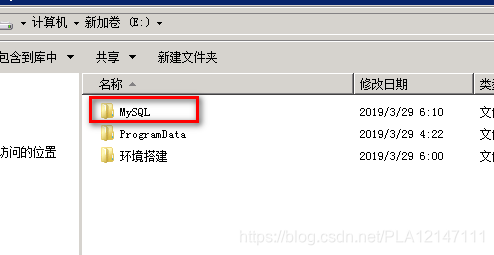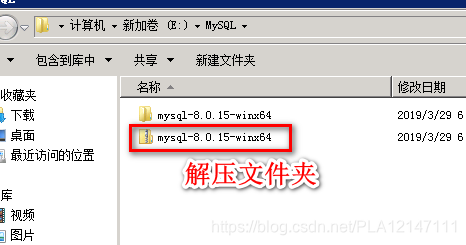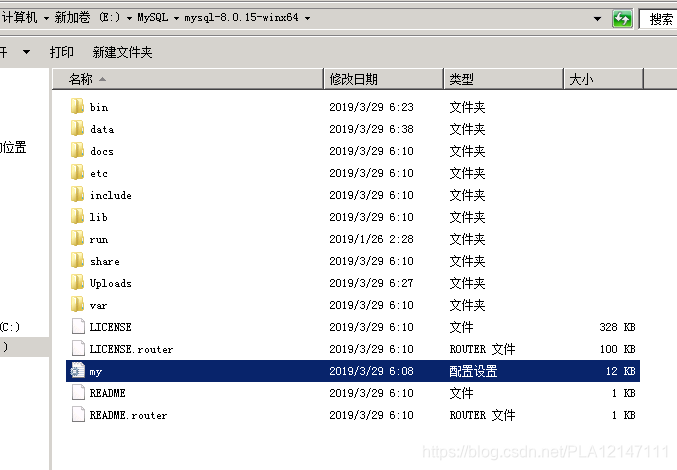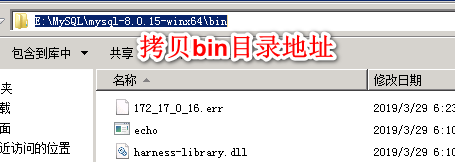之前经常给别人部署windows服务器,一直用的都是msi的傻瓜安装,简单快捷,但是有个很坑爹的问题就是默认只能安装在C盘,服务器的C盘本来空间就不大,你要数据多的话根本放不下,关于如何把数据迁移到其他盘,个人不建议这么做,8以上的版本非常容易出问题,在你解决问题的过程中,几乎都够你重新安装好几遍了.关于重新安装,数据如何同步,第一个是导出SQL,第二个是直接复制data文件夹(但是第二个我貌似没有成功,打开navicat的时候没有数据,但是我重新建表又提示已存在,结果我又把指定库的文件给删了重新用sql导入,具体原因,有空在研究一下吧,以下是zip包的安装方法,有错误之处欢迎指出)
1.在E盘下新建 MySQL 文件夹

2.将mysql-8.0.15-winx64.zip解压到MySQL目录下

3.本地新建文件名为:my.ini 配置文件,内容请根据自己的安装目录设置(位置1/2/3)
[client]
# pipe=
# socket=MYSQL
port=3306
[mysql]
no-beep
# default-character-set=
# SERVER SECTION
# ----------------------------------------------------------------------
#
# The following options will be read by the MySQL Server. Make sure that
# you have installed the server correctly (see above) so it reads this
# file.
#
# server_type=3
[mysqld]
# The next three options are mutually exclusive to SERVER_PORT below.
# skip-networking
# enable-named-pipe
# shared-memory
# shared-memory-base-name=MYSQL
# The Pipe the MySQL Server will use
# socket=mysql=MYSQL
# The TCP/IP Port the MySQL Server will listen on
port=3306
# Path to installation directory. All paths are usually resolved relative to this.
# basedir="C:/Program Files/MySQL/MySQL Server 8.0/"
# 修改位置1:==========================你的安装目录=======================================
basedir=E:\MySQL\mysql-8.0.15-winx64
# Path to the database root
#datadir=C:/ProgramData/MySQL/MySQL Server 8.0/Data
# 修改位置2:==========================你的数据存放位置=====================================
datadir=E:\MySQL\mysql-8.0.15-winx64\data
# The default character set that will be used when a new schema or table is
# created and no character set is defined
# character-set-server=
# The default authentication plugin to be used when connecting to the server
default_authentication_plugin=caching_sha2_password
# The default storage engine that will be used when create new tables when
default-storage-engine=INNODB
# Set the SQL mode to strict
sql-mode="STRICT_TRANS_TABLES,NO_ENGINE_SUBSTITUTION"
# General and Slow logging.
log-output=FILE
general-log=0
general_log_file="172_17_0_16.log"
slow-query-log=1
slow_query_log_file="172_17_0_16-slow.log"
long_query_time=10
# Binary Logging.
# log-bin
# Error Logging.
log-error="172_17_0_16.err"
# Server Id.
server-id=1
# Specifies the on how table names are stored in the metadata.
# If set to 0, will throw an error on case-insensitive operative systems
# If set to 1, table names are stored in lowercase on disk and comparisons are not case sensitive.
# If set to 2, table names are stored as given but compared in lowercase.
# This option also applies to database names and table aliases.
# NOTE: Modify this value after Server initialization won't take effect.
lower_case_table_names=1
# Secure File Priv.
#secure-file-priv="C:/ProgramData/MySQL/MySQL Server 8.0/Uploads"
# 修改位置3:============你的Uploads目录,如果此目录不存在,请自己新建一个,否则可能安装失败=================================
secure-file-priv="E:/MySQL/mysql-8.0.15-winx64/Uploads"
# The maximum amount of concurrent sessions the MySQL server will
# allow. One of these connections will be reserved for a user with
# SUPER privileges to allow the administrator to login even if the
# connection limit has been reached.
max_connections=151
# The number of open tables for all threads. Increasing this value
# increases the number of file descriptors that mysqld requires.
# Therefore you have to make sure to set the amount of open files
# allowed to at least 4096 in the variable "open-files-limit" in
# section [mysqld_safe]
table_open_cache=2000
# Maximum size for internal (in-memory) temporary tables. If a table
# grows larger than this value, it is automatically converted to disk
# based table This limitation is for a single table. There can be many
# of them.
tmp_table_size=16M
# How many threads we should keep in a cache for reuse. When a client
# disconnects, the client's threads are put in the cache if there aren't
# more than thread_cache_size threads from before. This greatly reduces
# the amount of thread creations needed if you have a lot of new
# connections. (Normally this doesn't give a notable performance
# improvement if you have a good thread implementation.)
thread_cache_size=10
#*** MyISAM Specific options
# The maximum size of the temporary file MySQL is allowed to use while
# recreating the index (during REPAIR, ALTER TABLE or LOAD DATA INFILE.
# If the file-size would be bigger than this, the index will be created
# through the key cache (which is slower).
myisam_max_sort_file_size=100G
# If the temporary file used for fast index creation would be bigger
# than using the key cache by the amount specified here, then prefer the
# key cache method. This is mainly used to force long character keys in
# large tables to use the slower key cache method to create the index.
myisam_sort_buffer_size=8M
# Size of the Key Buffer, used to cache index blocks for MyISAM tables.
# Do not set it larger than 30% of your available memory, as some memory
# is also required by the OS to cache rows. Even if you're not using
# MyISAM tables, you should still set it to 8-64M as it will also be
# used for internal temporary disk tables.
key_buffer_size=8M
# Size of the buffer used for doing full table scans of MyISAM tables.
# Allocated per thread, if a full scan is needed.
read_buffer_size=0
read_rnd_buffer_size=0
#*** INNODB Specific options ***
# innodb_data_home_dir=
# Use this option if you have a MySQL server with InnoDB support enabled
# but you do not plan to use it. This will save memory and disk space
# and speed up some things.
# skip-innodb
# If set to 1, InnoDB will flush (fsync) the transaction logs to the
# disk at each commit, which offers full ACID behavior. If you are
# willing to compromise this safety, and you are running small
# transactions, you may set this to 0 or 2 to reduce disk I/O to the
# logs. Value 0 means that the log is only written to the log file and
# the log file flushed to disk approximately once per second. Value 2
# means the log is written to the log file at each commit, but the log
# file is only flushed to disk approximately once per second.
innodb_flush_log_at_trx_commit=1
# The size of the buffer InnoDB uses for buffering log data. As soon as
# it is full, InnoDB will have to flush it to disk. As it is flushed
# once per second anyway, it does not make sense to have it very large
# (even with long transactions).
innodb_log_buffer_size=1M
# InnoDB, unlike MyISAM, uses a buffer pool to cache both indexes and
# row data. The bigger you set this the less disk I/O is needed to
# access data in tables. On a dedicated database server you may set this
# parameter up to 80% of the machine physical memory size. Do not set it
# too large, though, because competition of the physical memory may
# cause paging in the operating system. Note that on 32bit systems you
# might be limited to 2-3.5G of user level memory per process, so do not
# set it too high.
innodb_buffer_pool_size=8M
# Size of each log file in a log group. You should set the combined size
# of log files to about 25%-100% of your buffer pool size to avoid
# unneeded buffer pool flush activity on log file overwrite. However,
# note that a larger logfile size will increase the time needed for the
# recovery process.
innodb_log_file_size=48M
# Number of threads allowed inside the InnoDB kernel. The optimal value
# depends highly on the application, hardware as well as the OS
# scheduler properties. A too high value may lead to thread thrashing.
innodb_thread_concurrency=9
# The increment size (in MB) for extending the size of an auto-extend InnoDB system tablespace file when it becomes full.
innodb_autoextend_increment=64
# The number of regions that the InnoDB buffer pool is divided into.
# For systems with buffer pools in the multi-gigabyte range, dividing the buffer pool into separate instances can improve concurrency,
# by reducing contention as different threads read and write to cached pages.
innodb_buffer_pool_instances=8
# Determines the number of threads that can enter InnoDB concurrently.
innodb_concurrency_tickets=5000
# Specifies how long in milliseconds (ms) a block inserted into the old sublist must stay there after its first access before
# it can be moved to the new sublist.
innodb_old_blocks_time=1000
# It specifies the maximum number of .ibd files that MySQL can keep open at one time. The minimum value is 10.
innodb_open_files=300
# When this variable is enabled, InnoDB updates statistics during metadata statements.
innodb_stats_on_metadata=0
# When innodb_file_per_table is enabled (the default in 5.6.6 and higher), InnoDB stores the data and indexes for each newly created table
# in a separate .ibd file, rather than in the system tablespace.
innodb_file_per_table=1
# Use the following list of values: 0 for crc32, 1 for strict_crc32, 2 for innodb, 3 for strict_innodb, 4 for none, 5 for strict_none.
innodb_checksum_algorithm=0
# The number of outstanding connection requests MySQL can have.
# This option is useful when the main MySQL thread gets many connection requests in a very short time.
# It then takes some time (although very little) for the main thread to check the connection and start a new thread.
# The back_log value indicates how many requests can be stacked during this short time before MySQL momentarily
# stops answering new requests.
# You need to increase this only if you expect a large number of connections in a short period of time.
back_log=80
# If this is set to a nonzero value, all tables are closed every flush_time seconds to free up resources and
# synchronize unflushed data to disk.
# This option is best used only on systems with minimal resources.
flush_time=0
# The minimum size of the buffer that is used for plain index scans, range index scans, and joins that do not use
# indexes and thus perform full table scans.
join_buffer_size=256K
# The maximum size of one packet or any generated or intermediate string, or any parameter sent by the
# mysql_stmt_send_long_data() C API function.
max_allowed_packet=4M
# If more than this many successive connection requests from a host are interrupted without a successful connection,
# the server blocks that host from performing further connections.
max_connect_errors=100
# Changes the number of file descriptors available to mysqld.
# You should try increasing the value of this option if mysqld gives you the error "Too many open files".
open_files_limit=4161
# If you see many sort_merge_passes per second in SHOW GLOBAL STATUS output, you can consider increasing the
# sort_buffer_size value to speed up ORDER BY or GROUP BY operations that cannot be improved with query optimization
# or improved indexing.
sort_buffer_size=256K
# The number of table definitions (from .frm files) that can be stored in the definition cache.
# If you use a large number of tables, you can create a large table definition cache to speed up opening of tables.
# The table definition cache takes less space and does not use file descriptors, unlike the normal table cache.
# The minimum and default values are both 400.
table_definition_cache=1400
# Specify the maximum size of a row-based binary log event, in bytes.
# Rows are grouped into events smaller than this size if possible. The value should be a multiple of 256.
binlog_row_event_max_size=8K
# If the value of this variable is greater than 0, a replication slave synchronizes its master.info file to disk.
# (using fdatasync()) after every sync_master_info events.
sync_master_info=10000
# If the value of this variable is greater than 0, the MySQL server synchronizes its relay log to disk.
# (using fdatasync()) after every sync_relay_log writes to the relay log.
sync_relay_log=10000
# If the value of this variable is greater than 0, a replication slave synchronizes its relay-log.info file to disk.
# (using fdatasync()) after every sync_relay_log_info transactions.
sync_relay_log_info=10000
# Load mysql plugins at start."plugin_x ; plugin_y".
# plugin_load
# The TCP/IP Port the MySQL Server X Protocol will listen on.
loose_mysqlx_port=33060
4.将my.ini配置文件放在如下图位置(解压后的根目录):

5.设置环境变量(我的电脑→右键→属性→高级系统设置→环境变量→系统变量→Path→编辑):


6.在你mysql的bin目录下,按住SHIFT+鼠标右键,打开命令窗口(CMD):

7.执行以下命令:
mysqld --initialize --console

执行后会显示临时密码,最好在本地文本中写好,放在CMD窗口意外退出找不到密码!

8.继续执行命令:
mysqld --install
9.最后启动mysql服务
net start MySQL

如果MySQL 服务已经启动成功.那么直接进行第12步!
10.可能会发生服务无法启动的意外情况
MySQL 服务正在启动
MySQL 服务无法启动。
服务没有报告任何错误。
如出现上诉情况,继续执行CMD命令,打印信息到控制台
mysqld --console
有可能会提示端口被占用,或者文件夹不存在(No such file or directory),反正是一堆英文,自己百度翻译一下,这些问题都很好解决,类似抛出异常,只要有异常就知道哪里出问题了,文件夹不存在自己在哪个目录新建一个就可以了.端口被占用查一下哪个程序在用netstat -aon|findstr “3306”,kill掉.
11.执行启动命令(如果你第9部,服务启动成功了,那么直接12部)
net start MySQL
12.修改root密码
mysql -u root -p
回车后填入刚刚随机生成的那个临时密码,登录成功CMD是这样的

13.修改密码,执行完这一步基本就OK了,你可以用navicat for mysql试试看能不能连接
ALTER USER 'root'@'localhost' IDENTIFIED WITH mysql_native_password BY '密码';
flush privileges;
14.如果不想用root账号来进行操作的话,那么可以新建一个用户,后期使用完在将该用户删除,命令如下
#创建用户
CREATE USER 'longxin'@'%' IDENTIFIED BY 'jx170915_wlx';
#授权
GRANT ALL ON *.* TO 'username'@'%';
#删除用户
DROP USER 'username'@'host';
说明:username - 你将创建的用户名, host - 指定该用户在哪个主机上可以登陆,如果是本地用户可用localhost, 如果想让该用户可以从任意远程主机登陆,可以使用通配符%. password - 该用户的登陆密码,密码可以为空,如果为空则该用户可以不需要密码登陆服务器.
完!








 本文提供了一种在Windows服务器上安装MySQL的方法,包括使用ZIP包安装、配置my.ini文件、环境变量设置及服务启动步骤。
本文提供了一种在Windows服务器上安装MySQL的方法,包括使用ZIP包安装、配置my.ini文件、环境变量设置及服务启动步骤。
















 1194
1194

 被折叠的 条评论
为什么被折叠?
被折叠的 条评论
为什么被折叠?








